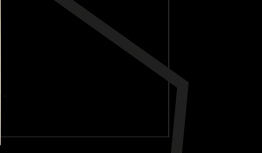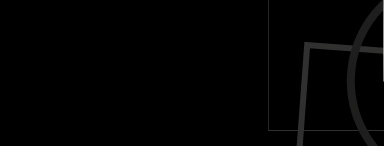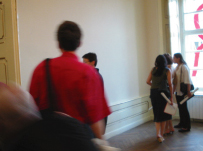![]() The artist "fallen into history"
The artist "fallen into history"
People looking at the walls, giant vice, red letters on the windows, newspapers
on the hallstand, heavy folders - this is what appears in the pictures from
the exhibition Ich habe keinen Zeitraum.
The drawings are traced discretely onto the walls, as if they were to erase,
as if they've been allowed there only a ghostly appearance.
To see them, one needs a special approaching, one to one, as in a whispered
(because forbidden) conversation. Some things cannot be told everywhere in
the same way - as the artist said, the most difficult thing is to speak to
those / about those one has always known.
Or maybe this reticence of the pencil to imprint too strong upon the walls
wants to show us - in a subtle and refined way - the reduced visibility of
Romanian contemporary art at its own home?
Why do the drawings from Kokerei Zollverein self-affirm themselves (although
white on black and not black on white) so clearly? As it was there a space
especially conceived for this kind of intervention while at the Brukenthal
museum the gesture calms down in the proximity of the silent masters, where
the wall is used mostly to the golden frames?
Probably the drawings describing this right museum, the city of Sibiu, the
baron von Brukenthal would have been enough to give the site-specificity of
the exhibition. The artist's decision to let himself hardly visible / readable
must be explained rather within the national context than within that one
which offered him, temporarily, the Zeitraum he misses.
It is proved that whoever wants to see the drawings, sees them, who cannot,
asks and is getting an explanation, and who doesn't want, complains about
the drawings which cannot be seen in the photographs. This is how the context
would be synthesized.
The folders containing the 22 magazine would illustrate it at leisure and
punctually. One could then see that the obsessions of Dan Perjovschi (for
which he has often been accused of radicalism) have no reason to disappear,
as long as the problems that generated them, instead of being solved, became
acute; that is, they haven't even been replaced by some new ones. "I
have the feeling that I'm writing identically about identical things…
I'm repeating the same dreams…" (22, issue 691)
Repetition, in this case, is not a teacher of knowledge, but the reaction
to the stimuli, or rather the lack of stimuli of an alienating world, that
only has short-time memory and cannot build even a decent present.
Artist "fallen into history" is not the same with an engaged artist.
The drawings of Dan Perjovschi are not political, nor revolutionary, they
don't support and don't accuse, they are just mirrors. Without exaggerating,
without caricaturing, they reflect a world that determines them and that they
cannot escape from.
The Henkel award, which occasioned the exhibition in Sibiu, was an award for
drawing. The drawing of Dan Perjovschi is a project in progress and in expansion,
the most ephemeral and the most lucid of all his projects.
Eastern Europe, Romania and NATO, the House of People, the Arts Universities,
the still imaginary museum of contemporary art, the contemporary artists and
their critics - Dan Perjovschi draws and writes about all these, continuing
to point out the absurd where others ignore it, the inconsistencies where
others practise them, confusion where the majority feels good with it. Why
does he persist in maintaining this position even when he is given the suggestion
there are others much more comfortable (and maybe trendier, as adopting the
ambiguity as a philosophy of life, the being Bohemian as an excuse and taking
the vagueness as common language…)? Maybe because he is an artist characterized
by intellectual honesty and moral authenticity, an artist articulating himself
completely in his works and not pretending to be someone else than he is.
Raluca Voinea















